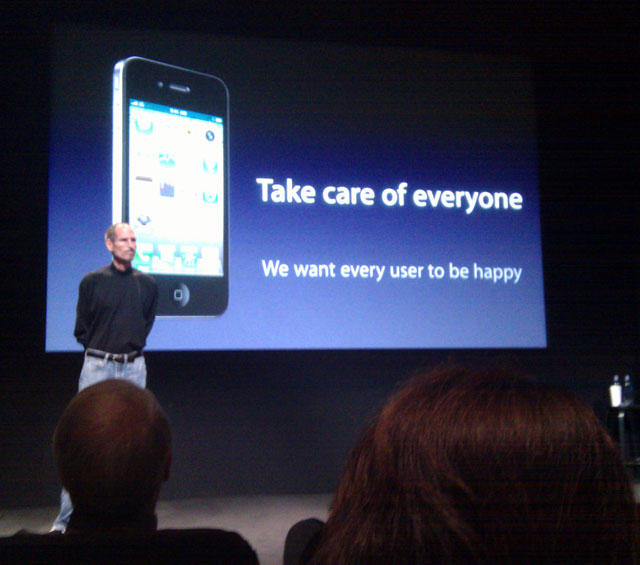PR expert Matt Seeger said Apple did issue a recall last Friday by providing iPhone 4 customers with free Bumper cases.
“From my perspective, this was a classic case of a recall,” said Seeger, who is chair of the Department of Communication at Wayne State University in Detroit. “They said, ‘Bring the product in, we’ll retrofit it.’ It’s not what most people think of as a recall, which is a safety issue. But this was a recall.”
Last week, Seeger and other experts in PR crisis management predicted that an iPhone 4 recall was “inevitable.”
Seeger said the term “recall” is fairly broad, and in academic terms, is associated with several kinds of retrofit or repair.
“There are many kinds of recalls and a voluntary recall where the company retrofits a new part to address a defect is a recall,” he said. In the car industry, for example, the kinds of recalls are known as service bulletins.
However, most people associate the word with safety recalls — voluntary or government-mandated product returns — which involve the physical return of a product.
“It’s a fairly broad term,” he said. “It doesn’t matter what Apple calls it. Whether Apple calls it a ‘present’ or a ‘fix’ is moot. The operative point is that Apple is trying to fix the problem.”
On Friday, Steve Jobs held a quickly organized press conference to address iPhone 4 reception problems. Jobs said all smartphones suffer from reception issues when held tightly, but nonetheless offered customers a free Bumper case or the chance to return their phones without paying a restocking fee.
However, Seeger said Apple’s offer of free Bumpers is a short-term fix, and that the company will have to redesign the iPhone 4 antenna.
“The long-term problem is not fixed,” he said. “This is about the brand image of Apple and how it responds to problems like this. They’re going to have to come back with a redesigned antenna to address the long-term problem.”
Likewise, Consumer Reports has said the offer of free cases is a short-term fix.
Seeger didn’t have a time-frame for the redesigned antenna, except to say it probably wasn’t any time soon. Apple will offer free cases until Sept. 30, when some have predicted the company may offer a new iPhone design or other hardware solution.
In fact, during Friday’s press conference, Steve Jobs hinted that a new antenna design was already underway.
“We will continue to work on more advanced antenna designs that don’t have this problem or put this problem in an out-of-the-way place,” Jobs said.

Leander Kahney is the editor and publisher of Cult of Mac.
Leander is a longtime technology reporter and the author of six acclaimed books about Apple, including two New York Times bestsellers: Jony Ive: The Genius Behind Apple’s Greatest Products and Inside Steve’s Brain, a biography of Steve Jobs.
He’s also written a top-selling biography of Apple CEO Tim Cook and authored Cult of Mac and Cult of iPod, which both won prestigious design awards. Most recently, he was co-author of Cult of Mac, 2nd Edition.
Leander has been reporting about Apple and technology for nearly 30 years.
Before founding Cult of Mac as an independent publication, Leander was news editor at Wired.com, where he was responsible for the day-to-day running of the Wired.com website. He headed up a team of six section editors, a dozen reporters and a large pool of freelancers. Together the team produced a daily digest of stories about the impact of science and technology, and won several awards, including several Webby Awards, 2X Knight-Batten Awards for Innovation in Journalism and the 2010 MIN (Magazine Industry Newsletter) award for best blog, among others.
Before being promoted to news editor, Leander was Wired.com’s senior reporter, primarily covering Apple. During that time, Leander published a ton of scoops, including the first in-depth report about the development of the iPod. Leander attended almost every keynote speech and special product launch presented by Steve Jobs, including the historic launches of the iPhone and iPad. He also reported from almost every Macworld Expo in the late ’90s and early ‘2000s, including, sadly, the last shows in Boston, San Francisco and Tokyo. His reporting for Wired.com formed the basis of the first Cult of Mac book, and subsequently this website.
Before joining Wired, Leander was a senior reporter at the legendary MacWeek, the storied and long-running weekly that documented Apple and its community in the 1980s and ’90s.
Leander has written for Wired magazine (including the Issue 16.04 cover story about Steve Jobs’ leadership at Apple, entitled Evil/Genius), Scientific American, The Guardian, The Observer, The San Francisco Chronicle and many other publications.
Leander is an expert on:
Apple and Apple history
Steve Jobs, Jony Ive, Tim Cook and Apple leadership
Apple community
iPhone and iOS
iPad and iPadOS
Mac and macOS
Apple Watch and watchOS
Apple TV and tvOS
AirPods
Leander has a postgrad diploma in artificial intelligence from the University of Aberdeen, and a BSc (Hons) in experimental psychology from the University of Sussex.
He has a diploma in journalism from the UK’s National Council for the Training of Journalists.
Leander lives in San Francisco, California, and is married with four children. He’s an avid biker and has ridden in many long-distance bike events, including California’s legendary Death Ride.
You can find out more about Leander on LinkedIn and Facebook. You can follow him on X at @lkahney or Instagram.


